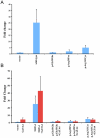Mutation analysis of NR5A1 encoding steroidogenic factor 1 in 77 patients with 46, XY disorders of sex development (DSD) including hypospadias
- PMID: 22028768
- PMCID: PMC3197579
- DOI: 10.1371/journal.pone.0024117
Mutation analysis of NR5A1 encoding steroidogenic factor 1 in 77 patients with 46, XY disorders of sex development (DSD) including hypospadias
Abstract
Background: Mutations of the NR5A1 gene encoding steroidogenic factor-1 have been reported in association with a wide spectrum of 46,XY DSD (Disorder of Sex Development) phenotypes including severe forms of hypospadias.
Methodology/principal findings: We evaluated the frequency of NR5A1 gene mutations in a large series of patients presenting with 46,XY DSD and hypospadias. Based on their clinical presentation 77 patients were classified either as complete or partial gonadal dysgenesis (uterus seen at genitography and/or surgery, n = 11), ambiguous external genitalia without uterus (n = 33) or hypospadias (n = 33). We identified heterozygous NR5A1 mutations in 4 cases of ambiguous external genitalia without uterus (12.1%; p.Trp279Arg, pArg39Pro, c.390delG, c140_141insCACG) and a de novo missense mutation in one case with distal hypospadias (3%; p.Arg313Cys). Mutant proteins showed reduced transactivation activity and mutants p.Arg39Pro and p.Arg313Cys did not synergize with the GATA4 cofactor to stimulate reporter gene activity, although they retained their ability to physically interact with the GATA4 protein.
Conclusions/significance: Mutations in NR5A1 were observed in 5/77 (6.5%) cases of 46,XY DSD including hypospadias. Excluding the cases of 46,XY gonadal dysgenesis the incidence of NR5A1 mutations was 5/66 (7.6%). An individual with isolated distal hypopadias carried a de novo heterozygous missense mutation, thus extending the range of phenotypes associated with NR5A1 mutations and suggesting that this group of patients should be screened for NR5A1 mutations.
Conflict of interest statement
Figures




References
-
- Baskin LS, Ebbers MB. Hypospadias: anatomy, etiologie, and technique. J Pediatr Surg. 2006;41:463–472. - PubMed
-
- Mortlock DP, Innis JW. Mutation of HOXA13 in hand-foot-genital syndrome. Nat Genet. 1997;15:179–180. - PubMed
-
- Fukami M, Wada Y, Miyabayashi K, Nishino I, Hasegawa T, et al. CXorf6 is a causative gene for hypospadias. Nat Genet. 2006;38:1369–1371. - PubMed
-
- Beleza-Meireles A, Lundberg F, Lagerstedt K, Zhou X, Omrani D, et al. FGFR2, FGF8, FGF10 and BMP7 as candidate genes for hypospadias. Eur J Hum Genet. 2007;15:405–410. - PubMed
Publication types
MeSH terms
Substances
LinkOut - more resources
Full Text Sources

